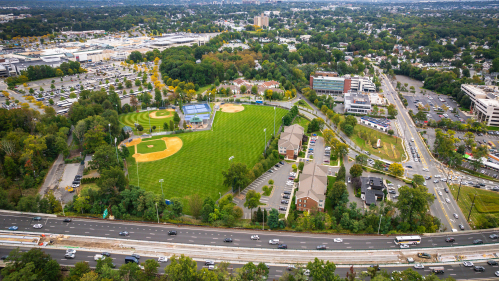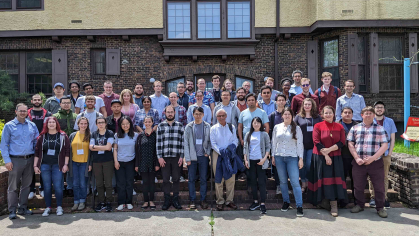Rutgers-Eagleton Poll: Is the Garden State a Good Place to Live?

Six in 10 New Jerseyans rate garden state as excellent or good place to live, yet one-third want to move out of New Jersey
Almost six in 10 New Jersey residents say the Garden State is an “excellent” (14 percent) or “good” (44 percent) place to live, according to a new Rutgers-Eagleton Poll. Twenty-eight percent rate it as “only fair” and another 13 percent as “poor.”
“New Jerseyans’ views on the Garden State as a place to live have remained stable the past several years but over the decades have gradually become less positive,” said Ashley Koning, an assistant research professor and director of the Eagleton Center for Public Interest Polling (ECPIP) at Rutgers University–New Brunswick. “Three-quarters of residents said the state was an excellent or good place to live back in the mid 1990s to early 2000s. Even more – eight in 10 residents – said the same throughout the mid to late 1980s.”
Residents continue to like where they live. When it comes to rating their cities, towns, and neighborhoods, 70 percent say their town or city is an “excellent” (26 percent) or “good” (44 percent) place to live. Seventy-five percent say the same about their neighborhood (34 percent “excellent,” 41 percent “good”).
Still, half of New Jerseyans say they would like to move out of their current neighborhood if given the opportunity: 3 percent would move within the same town, 15 percent would move to another town in New Jersey, and 36 percent say they would move to another state. Forty-two percent would continue living where they are now.
“New Jerseyans’ desire to move has increased by double digits over the last decade,” said Koning. “These latest numbers set an all-time high in the poll’s history of asking this question for those who want to move out of state and an all-time low for those who want to stay.”
When it comes to rating New Jersey as a place to live on a variety of specific areas, three-quarters of residents look favorably on getting an education (30 percent say “excellent,” 42 percent “good”) or for entertainment and recreation (29 percent “excellent,” 45 percent “good”). Two-thirds say New Jersey is an “excellent” (21 percent) or “good” (45 percent) place to raise a family.
In terms of employment and industry, two-thirds say the Garden State is an “excellent” (17 percent) or “good” (47 percent) place to find a job, and half say it is an “excellent” (12 percent) or “good” (38 percent) place to run a business.
Only when it comes to retirement do New Jerseyans give the state an upside-down rating— 48 percent say the state is a “poor” place to settle down and retire, and another 27 percent say it is “fair.”
“Views on New Jersey as a place to raise a family, get an education, enjoy entertainment, find a job, run a business, and even retire have gone up since last measured in 2015,” noted Koning. “Positivity about jobs and business ownership stand out with ratings on the former double what they were seven years ago and ratings on the latter up by double digits.”
Results are from a statewide poll of 1,044 adults contacted by live interviewers on landlines and cell phones from February 25 – March 4. The full sample has a margin of error of +/- 3.5 percentage points.
Quality of life in the garden state depends on who you ask
Democrats are more content in New Jersey than either independents or Republicans; 74 percent rate life in the Garden State as “excellent” or “good,” compared to 54 percent of independents and 47 percent of Republicans. Besides Republicans, South Jersey residents (50 percent), those in the lowest income bracket (52 percent), and those with a high school education or less (51 percent) are the only other groups where about half rate the state negatively as a place to live.
New Jerseyans’ positivity about their towns and neighborhoods fluctuates depending on the group. White residents give more positive local ratings than Black residents or Hispanic residents by double-digits. About eight in 10 white residents rate their town or city as at least a “good” place to live, compared to 54 percent of Black residents and 65 percent of Hispanic residents. This trend is similar within neighborhood ratings; about eight in 10 white residents again say their neighborhood is at least a “good” place to live, as compared to six in 10 Black residents and seven in 10 Hispanic residents. Positivity around both city or town and neighborhood grows with income and education.
Those living in the urban areas are less positive about their towns or cities (57 percent “excellent” or “good”) than those living in other areas, where anywhere from 68 to 78 percent say their town or city is an “excellent” or “good” place to live.
When it comes to rating individual aspects of life in New Jersey, Democrats are about twice as likely as Republicans to say the state is an “excellent” place to raise a family (30 percent versus 16 percent), find a job (22 percent versus 12 percent), get an education (41 percent versus 19 percent), retire (13 percent versus 7 percent), or run a business (17 percent versus 7 percent), as well as slightly more likely to say the same about the state as a place for entertainment and recreation (35 percent versus 23 percent).
Women are three times as likely as men to say the state is an “excellent” place to run a business (18 percent versus 6 percent, respectively).
Non-Hispanic white New Jerseyans are more likely than non-white residents to believe New Jersey is an “excellent” place for entertainment and recreation (33 percent versus 24 percent). Non-white residents, however, are twice as likely as white residents to say the state is an “excellent” place to run a business (18 percent versus 9 percent). While white and non-white residents say the state is an “excellent” place to find a job at about the same rate (16 and 17 percent, respectively), non-white residents are more than twice as likely to say it is a “poor” place to find a job as compared to non-Hispanic white residents (15 versus 6 percent).
Those in households making $100,000 or more annually are more likely than those making less to say New Jersey is an “excellent” place to raise a family (27 versus 16 percent) and find a job (24 versus 12 percent).
Views on New Jersey as a place to get an education differ by educational attainment. Notably, 41 percent of those with a 4-year college degree or more feel the state is an “excellent” place to get an education compared to 23 percent of those with some college education or less schooling.
“Even though these area-specific ratings are up overall, it is important to recognize the nuances of different perspectives,” said Jessica Roman, a research associate at ECPIP. “Though some may find the state to be a hub for academia and business, for example, others may face barriers or challenges in either accessing or navigating these systems. The same could be said for any part of daily life in New Jersey.”
Who wants to move out?
While partisans of all stripes say they want to continue living where they do now in similar numbers, Democrats (20 percent) are slightly more likely than their counterparts to say they want to move within New Jersey, while Republicans are slightly more likely to say they want to move outside of the state (43 percent).
White residents (50 percent) are more likely than Black residents (34 percent) or Hispanic residents (32 percent) to want to remain in their current neighborhood. Black residents and Hispanic residents, on the other hand, have a greater desire to move to another town in New Jersey (19 percent and 22 percent, respectively).
New Jerseyans aged 18 to 34 are the least likely of any age to say they want to continue living in their current neighborhood (26 percent). Urban residents (also 26 percent) tie with these younger New Jerseyans for the demographic group least likely to want to stay in the neighborhood in which they presently live (26 percent). A solid majority of senior citizens (65 percent), on the other hand, want to stay in the neighborhood where they currently live – the most likely to say so of any demographic.
Urban residents are the most likely of any region to want to move to another town within New Jersey (28 percent).
Read the full report.


